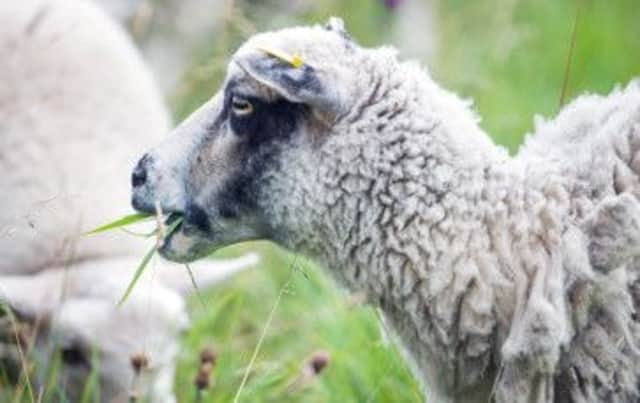Cash plea to keep sheep who eat invasive species


Known as the nation’s “Flying Flock”, a hit squad of around 300 hardy sheep travels the length and breadth of Scotland eating species that are endangering biodiverse wildflower meadows.
However the unit is now itself under threat because of a funding crisis, and the Scottish Wildlife Trust (SWT) has issued an urgent appeal for £20,000 to allow its work to continue.
Advertisement
Hide AdAdvertisement
Hide AdScotland has seen a 90 per cent decline in species-rich grassland over the past five decades and conservationists face an uphill battle to save the meadows, which are among the most threatened wildlife habitat in the country.
One of the places the Flying Flock has been deployed is Bo’mains Meadow near Falkirk, which had been increasingly blighted in recent years by invasive species such as creeping thistle (Cirsium arvense) restricting the growth of more vulnerable plants such as the greater butterfly orchid (Platanthera chlorantha).
The sheep eat the thistles and coarse grass without hesitation, allowing the wildflowers to grow and spread.
SWT spokesman Ryan Gavan said the flock has produced remarkable results.
“This type of grassland at Bo’mains, which is the only Site of Scientific Interest of its kind in the Falkirk and Clackmannanshire area, is among the most threatened,” Gavan said.
“But after four years of rotation grazing, the wildflowers are really flourishing and we are seeing a whole host of species, such as ox-eye daisy (Leucanthemum vulgare), orange hawkweed (Pilosella aurantiaca), yellow rattle (Rhinanthus minor) and the common spotted orchid (Dactylorhiza fuchsii).”
The flock costs £40,000 a year to operate, which pays for transport and the salary of a shepherd. It is funded from a variety of sources including Scottish Natural Heritage, European agricultural funding, Heritage Lottery and donations from SWT supporters and members.
Gavan added that while the charity was applying for a grant to help fund the flock for three years from January 2014, financial support was needed to keep their work going.
Advertisement
Hide AdAdvertisement
Hide AdLaura Cunningham, SWT’s conservation shepherd, who transports and tends the flock of small hardy Shetland sheep, said each member of the team had its own individual personality.
She said they travel in a “sheepmobile” designed specially for the small breed, with a built-in lift to help some of them on to the top floor of the vehicle.
Cunningham said: “Let’s put it like this, I know most of them and I know who the troublemakers are. They are the ones who are going to try to get out. Their main aim in life is to escape.
“Other breeds of sheep would just go and graze in the next fields but Shetlands are small and can fit through a smaller gap and they like to go for a long ramble around the country. So I need to make sure they are well fenced in.
“I admit my job is a bit different. I don’t know anyone who has a job like mine. It’s very involved, very 24/7 and a lot goes into making sure everything is right.”
Cunningham, 33, a former dog trainer, said there was no better way to manage Scotland’s grassland wildlife reserves than her hardy flock of sheep.
She said: “Using a tractor would obliterate everything and would cost money and wouldn’t give anything back. Using a strimmer or machine would just flatten the grass in the meadow to the same length but the sheep graze it down to different lengths at different times of the year.
“It costs money to run the flock but they do pay us back in many ways.” The flock is split into groups of between ten and 20 and sent to wildlife reserves such as Aberlady Bay in East Lothian and Fleecefaulds Meadow, near Cupar, all-year round.
Advertisement
Hide AdAdvertisement
Hide AdUnlike commercially-bred breeds used to a more luxury lifestyle sleeping in sheds and barns, the Flying Flock sleep out in fields.
Both Aberlady and Fleecefaulds Meadow have been chosen as two of the UK’s top 60 Coronation Meadows, a project led by the Prince of Wales as part of celebrations to mark the Queen’s 60th year as monarch. The Flying Flock has also maintained the grassy spirals in a landform designed by internationally-renowned architect Charles Jencks at the Scottish World Project in Kelty, Fife.
Their wool, along with that of sheep from other flocks, has been used in a tapestry entitled “Large Tree Group” part of the “Fleece to Fibre” exhibition running at the Dovecot Studios in Edinburgh until 14 September.
But it’s not all showbiz. When flock members reach retirement age and have fulfilled their mission they are slaughtered. Their meat is in high demand and is sold to trust members and individuals and has graced the menus of Scotland’s leading chefs, including Michelin-starred Tom Kitchin.
Twitter: @ScotsmanShanR